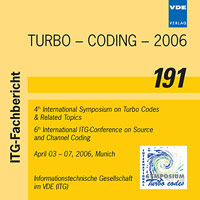Ungerboeck Metric versus Forney Metric in Reduced-State Multi-User Detectors
Konferenz: TURBO - CODING - 2006 - 4th International Symposium on Turbo Codes & Related Topics; 6th International ITG-Conference on Source and Channel Coding
03.04.2006 - 07.04.2006 in Munich, Germany
Tagungsband: TURBO - CODING - 2006
Seiten: 5Sprache: EnglischTyp: PDF
Persönliche VDE-Mitglieder erhalten auf diesen Artikel 10% Rabatt
Autoren:
Badri-Hoeher, Sabah; Hoeher, Peter Adam; Chen, Huan (Faculty of Engineering, University of Kiel, Kaiserstr. 2, 24143 Kiel, Germany)
Krakowski, Claudiu; Xu, Wen (BenQ Mobile GmbH & Co. OHG, Haidenauplatz 1, 81667 Munich, Germany)
Inhalt:
In this paper, a derivation and comparison of trellis-based multi-user detectors based on the so-called Forney metric and the Ungerboeck metric, respectively, is presented. Full-state detection (JMLSE) and reduced-state detection (JDDFSE) is considered. Similar to the corresponding single-user detectors, the performance of both full-state detectors is the same. In case of reduced-state detection, the performance is different, however. The Ungerboeck metric is shown, for a wide range of C=I values, to be more robust if the number of states is moderately or extremely reduced. Therefore, adaptive state allocation (previously proposed for the Forney metric) is not necessary. Concerning computational complexity, many terms can be calculated off-line when using the Ungerboeck metric. As a possible application, co-channel interference cancellation is considered in the numerical results.


